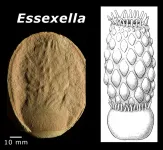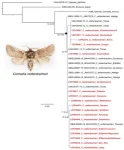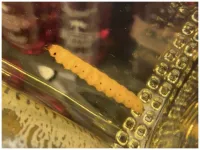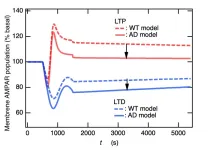(Press-News.org) Billions of sea anemones adorn the bottom of the Earth’s oceans — yet they are among the rarest of fossils because their squishy bodies lack easily fossilized hard parts. Now a team of paleontologists has discovered that countless sea anemone fossils have been hiding in plain sight for nearly 50 years.
In a newly published paper in the journal Papers in Palaeontology, University of Illinois Chicago’s Roy Plotnick and colleagues report that fossils long-interpreted as jellyfish were anemones. To do so, they simply turned the ancient animals upside down.
“Anemones are basically flipped jellyfish. This study demonstrates how a simple shift of a mental image can lead to new ideas and interpretations,” said Plotnick, UIC professor emeritus of earth and environmental sciences and the study’s lead author.
The fossils come from the 310-million-year-old Mazon Creek fossil deposits of northern Illinois. Mazon Creek is a world-famous Lagerstätte, a term used by paleontologists to describe a site with exceptional fossil preservation. An ancient delta allowed the detailed preservation of the Mazon Creek soft-bodied organisms because millions of anemones and other animals were rapidly buried in muddy sediments.
“These fossils are better preserved than Twinkies after an apocalypse. In part that’s because many of them burrowed into the seafloor as they were being buried by a stormy avalanche of mud,” said study co-author James Hagadorn, an expert on unusual fossil preservation at the Denver Museum of Nature and Science.
By far the most common fossil at Mazon Creek is the form known to local recreational fossil collectors as “the blob,” according to Plotnick, who notes that such blobs were so common and often nondescript that many were discarded or sold for a few dollars at local flea markets. Nevertheless, avocational collectors donated nearly all of the specimens in museum collections.
In 1979, Bradley University professor Merrill Foster made the first detailed study of the blobs. He decided that they were jellyfish and named them Essexella asherae. Foster reported these jellyfish had a unique feature found in no living jellyfish. This was a tough “curtain” that hung off its umbrella-like bell — the top part of a jellyfish — akin to a skirt that enclosed their arms and tentacles, accounting for their barrel-like shapes.
Plotnick said that Foster also suggested that a small snail sometimes found in the skirt was a predator, similar to snails that prey on jellyfish in modern oceans.
In their new paper, the paleontologists took a fresh look at Essexella by examining thousands of museum specimens.
“It quickly became obvious that not only it wasn’t a jellyfish, but turned upside down it was clearly an anemone, probably one that burrowed into the seafloor. The ‘bell’ was actually an expanded muscular foot used to wiggle the anemone into the seafloor,” Plotnick said.
The tough “curtain” was the barrel-shaped body of the anemone. Another fossil jellyfish species that looked like a daisy turned out to represent rare anemones squashed from top to bottom, like one might stomp an aluminum can.
“Although most of these fossils are preserved as decomposing blobs that look like a piece of used gum on the sidewalk, some specimens are so superbly preserved that we can even see the muscles that the anemones used to bend and contract their bodies,” said study co-author Graham Young, an expert on fossil jellyfish from the Manitoba Museum.
The researchers explain that the wide variety of preservation seen in Essexella specimens was due to the different durations that dead anemones sat on the seafloor before burial. The snail was not a predator, but a scavenger on the carcasses.
“When jellies like Essexella wash up onto the beach, they become a veritable beachside buffet, being snacked on by snails and other creatures like we see in this fossil deposit,” Young said.
The team also suggested that a common trace fossil from the same period, long believed to be an anemone burrow, was made by an animal similar to Essexella. Because Essexella is so abundant, it may have lived in large aggregations on the sea floor, they report.
END
Paleontologists flip the script on anemone fossils
2023-03-08
ELSE PRESS RELEASES FROM THIS DATE:
Mezcal worm in a bottle: DNA evidence suggests a single moth species
2023-03-08
A new study published in PeerJ Life & Environment looked to identify the species of larva found in bottles of Mezcal. Mezcal is a distilled alcoholic beverage made from any type of agave.
Are people consuming larvae of the skipper butterfly Aegiale hesperiaris, or the larva of the moth Comadia redtenbacheri, the latter which is thought to be declining in numbers in recent years? Or is the worm the larva of a weevil, or another unidentified insect species? Researchers used DNA-based identification analysis of larvae inside 21 commercially ...
New device for lower extremity rehabilitation receives FDA approval!
2023-03-08
COTRAS Co., Ltd. (hereon referred to as COTRAS), an innovative medical-device firm focused on rehabilitation products, has secured approval from the U.S. Food and Drug Administration (FDA) for MOBILISE, a medical device to help degenerative knee arthritis patients.
MOBILISE has been promoted among UNIST (Professor Sang Hoon Kang), COTRAS Co., Ltd. (hereon referred to as COTRAS), Korea Institute of Science and Technology (KIST), and Seoul National University Bundang Hospital (SNUH). The aim is to further develop the original technology created by UNIST ...
First nasal monoclonal antibody treatment for COVID-19 shows promise for treating virus, other diseases
2023-03-08
In a pilot trial and clinical sample-based investigations, the drug Foralumab decreased inflammatory markers in patients with COVID-19
Similar reduction in inflammatory markers were seen when given to patients with multiple sclerosis
A pilot trial by investigators from Brigham and Women’s Hospital, a founding member of the Mass General Brigham healthcare system, tested the nasal administration of the drug Foralumab, an anti-CD3 monoclonal antibody. Investigators found evidence that the drug dampened the inflammatory T cell response and decreased lung inflammation in patients with COVID-19. Further analysis showed the same gene expression modulation in patients ...
Scientists show how gene expression controls synaptic plasticity in the aging human brain
2023-03-08
Scientific evidence shows how the cognitive decline in Alzheimer’s disease (AD) is caused by the buildup of amyloid beta proteins, which promote synaptic malfunction. One of the neuropathological features in the brains of patients with AD is the degeneration of the basal forebrain cholinergic neurons, leading to a decrease in the number of cholinergic projections to the hippocampus. As a symptomatic treatment of AD, cholinergic neurotransmission is enhanced by the use of certain drugs, known as acetylcholinesterase inhibitors. For better prevention and treatment of cognitive disorders like AD and schizophrenia, it is necessary to understand how acetylcholine regulates synaptic transmissions.
Higher ...
UTSA ScooterLab receives $1.7M NSF award to deploy a fleet of data collecting e-scooters
2023-03-08
When a speedy campus scooter nearly collided with Murtuza Jadliwala, he had an epiphany. The micro-mobility form of transportation could be a vehicle for change.
Scooters carry people as well as sensors—sensors that can collect a wealth of data. This data is key to improving the quality of life. With that in mind, Jadliwala, an associate professor in the UTSA Department of Computer Science, created the ScooterLab, which has received a $1.7M grant from the National Science Foundation.
“This funding is critical for ScooterLab as it enables us to take this community research infrastructure from vision to reality,” Jadliwala said. “We are hoping that our new research ...
Two-year mission to study human impact on Europe’s seas and coastal regions
2023-03-08
Europe’s coastlines are environments rich in biodiversity that also represent important sites of industry, culture, and heritage. Forty per cent of Europe’s population live within a coastal region, and many European societies have been, and still are, defined by their relationships with the sea.
Our seas and coasts represent key ecosystems that host an extremely rich diversity of life and play critical roles in the stability and sustainability of wider ecosystems. However, anthropogenic interferences such as pollution, farming, and building ...
Do school shootings increase stress-related emergency department visits in local communities?
2023-03-08
New research in Contemporary Economic Policy reveals that school shootings may worsen mental health in surrounding communities and increase health system costs.
For the study, investigators compared the number of stress-related emergency department visits by California residents in zip-codes within 5 miles of school shootings and by California residents in zip-codes 10–15 miles from school shootings, both before and after these violent events.
Compared with before school shootings, exposure to school shootings and to fatal school shootings was associated with increases of 0.7 and 1.5 ...
Blocking gene that inhibits root growth may enhance drought resistance in crops
2023-03-08
A strong root system allows crops to absorb water and nutrients from the soil, but scientists have little information about the genes that control root development. Recent research published in New Phytologist reveals that blocking a negative regulator gene of root development leads to enhanced root growth in plants.
The gene, called RRS1 (Robust Root System 1), encodes an R2R3-type MYB family transcription factor that activates the expression of another gene (OsIAA3) that inhibits root growth. Knocking out RRS1 in plants led to longer root length, longer lateral root length, and larger lateral root density. Also, a natural variant of RRS1 ...
Could having an irregular heart rhythm affect a person’s risk of developing dementia?
2023-03-08
In a large study of diverse adults in California, individuals with newly diagnosed atrial fibrillation, or an irregular heart rhythm, had a modestly elevated risk of developing dementia. The Journal of the American Heart Association study found that this risk was higher in younger adults and those without chronic kidney disease, but did not substantially vary across sex, race, or ethnicity.
In the study of nearly 200,000 adults, incidence rates for dementia over a median follow-up of 3.3 years were 2.79 versus 2.04 per ...
Can virtual reality tools help teach obstetrics and gynecology topics to medical students?
2023-03-08
Results from a trial published in the International Journal of Gynecology & Obstetrics support the benefit of 3D virtual reality lessons to improve medical students’ knowledge and understanding of complex topics in obstetrics and gynecology.
For the study, 21 students took part in a 15-minute virtual reality learning environment (VRLE) experience on the stages of fetal development, and 20 students received a PowerPoint tutorial on the same topic.
Knowledge increased after both learning experiences, but it was only retained in the VRLE group at one-week follow up. Questionnaires completed by participants reflected a high ...







